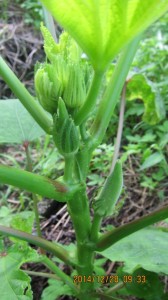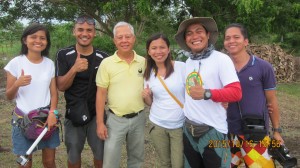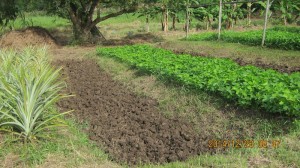ZARRAGA
FEBRUARY 2020
Fostering Environmental Stewardship: A Closer Look at Local Initiatives
In the pursuit of sustainable and eco-friendly practices, communities around the world are increasingly turning their attention to environmental education and conservation efforts. One such commendable initiative took place recently at Balud II Elementary School, where a vibrant Environmental Forum brought together 67 enthusiastic participants. This diverse group comprised teachers, pupils, barangay officials, parents, and dedicated SEA staff.
The forum served as a platform for knowledge exchange and collaborative discussions on pressing environmental issues. Participants engaged in insightful conversations about the importance of environmental conservation, sustainable practices, and the role each individual can play in preserving the planet for future generations.
A significant aspect of the environmental conservation efforts in the region is the establishment and enhancement of nursery in partner school, Balud II Elementary School had embarked on this journey. The school received a substantial SEA counterpart of Php 10,000.00 to support the establishment and improvement of the nursery.
The financial assistance provided by SEA serves as a catalyst for these schools to create and maintain nurturing environments for young plants. The funds are used for procuring essential materials, implementing sustainable practices, and ensuring the overall success of the nursery programs. This collaboration between schools and the SEA program exemplifies the power of community-driven initiatives and underscores the importance of collective efforts in preserving our environment.
As these schools actively participate in environmental projects, the ripple effect is evident not only in the increased green cover but also in the growing environmental awareness within the community. Students, teachers, and parents alike are becoming ambassadors for environmental sustainability, spreading the message of responsible stewardship beyond the confines of the classroom.
The success of the initiatives at Balud II Elementary School serves as a testament to the positive impact that local, community-driven environmental projects can have. It is a reminder that every small step, when taken collectively, contributes to a more sustainable and environmentally conscious future. As these initiatives continue to grow and multiply, they inspire hope for a greener and healthier planet for generations to come.
SEA Empowers Zarraga’s Organic Farming: Paving the Way for Sustainability and Market Expansion
SEA played a pivotal role in establishing Zarraga’s exclusive Organic Farming Trading Post, aimed at marketing organic products. Furthermore, SEA facilitated connections between the town and Johnny Que, a certified organic farmer and co-owner of seven supermarket chains in Iloilo City, located 20 miles away from Zarraga. Que’s supermarkets now serve as additional distribution outlets for organic products, with Iloilo Supermart, the brand, becoming an integral part of the organic product value chain. Despite these positive developments, Que’s existing supply of organic vegetables proved insufficient to meet the high demand in Iloilo City.
Continuing its commitment, SEA remains actively engaged in uncovering various facets of the value chain as part of its ongoing efforts for the Zarraga Agriculture Program.
The Flagship Project of the Ecological Dimension of Zarraga-SIAD or Larga Sustainable Zarraga is AWE or Appreciation through Working Examples. The key initiative of AWE is Vidar Farm 2.0, a nationally known pioneer in organic and bio-dynamic agriculture in the Philippines. This initiative represents a significant step forward in promoting sustainable and environmentally friendly farming practices in the region.
The specific objectives of AWE have already been explained . Below are updates in pictures.
Vidar Farm
Vidar Farm was a 3 hectare farm at the heart of Diliman, Quezon City, Metro Manila. In 1989, it was the country’s first commercial organic and bio-dynamic farm. It helped launched the organic farming movement in the Philippines. Thousands of people from all walks of life visited the farm yearly at the height of its popularity. And Vidar Farm trained thousands of people in organic and bio-dynamic farming in 25 provinces throughout the Philippines. It was regularly in the national newspapers and TV. We won many national and global awards because of this farm and what it did and inspired others to do. Many college and graduate students did their thesis work on the farm. Most of all it demonstrated, at time of extreme skepticism, that you can commercially farm without artificial fertilizers and toxic pesticide using the organic and/or bio-dynamic agriculture approach.
We are taking all the experiences and lessons learned from this initiative and transferring it into our new location in Barangay Libongcogon, Zarraga, Iloilo. Not only are we bringing its overall framework. We are placing it in a more holistic and development context as an ecological part of the larger effort of helping a whole town achieve sustainable integrated area development (SIAD).
Vidar Farm 2.0
This is the reason why we are now calling it Vidar 2.0. It is the rebirth of the former Vidar Farm but now in a different location and context. Zarraga’s Technical Working Group on Organic Agriculture has certified Vidar 2.0 as an organic farm.
Vidar is the Scandanavian god who overcomes all opposing powers after “Gotterdamerung” or the twilight of the gods. Vidar represents the power of resurrection. In this particular case, Vidar is an apt symbol for strength of will and character to undertake organic/bio-dynamic farming. Vidar is also a symbol for the resurrection power than can change chemical farms to organic farms.
We have lofty aspirations for this farm. But it is not a sky-in-the-pie dream. It is based on a past reality that was achieved and inspired by a future that is clear and doable.
Research Center for Climate Change Adapted (CCA) Cropping Systems
The most important thing to note about Vidar Farm is that it is consciously developing what we call climate change adapted (CCA) cropping systems. We are located in a floodplain. We have floods twice a year on the average. Flood waters can reach 6 feet or more.
See the picture immediately below. The cemented raised beds are 4 feet high. Yet the floods surpass these cemented beds.
But this works to our advantage. We do not have to artificially simulate flooding to conduct our research and experiments on climate change adapted farming systems! Nature gives it to us. We just have to do proper trials and selection under the given situation.
Sorjan Farming System
One approach we have taken is to try out the Sorjan Farming System. This is lowland rice farming adaptation that we saw is being use in wide areas in Vietnam. Other researchers say that Indonesia also has a lot of Sorjan farming system. In its essence, we plant rice where it tends to flood. Rice, of course, is flooding tolerant by its very nature. And then we plant other crops (such as soybeans) in the beds that have been raised around 0.5 meters above ground. In effect, the Sorjan approach forces you to diversity your cropping system, an important practice in organic farming. See pictures below.
Network of Canals
Water management is an essential part of the CCA package. We have built an extensive network of canals to immediately drain excess water where it is not needed. In the alternative, we can control this canals in such a way that it will retain water where we need it, for example, our rice crops.
Natural Selection
Another approach is to just plant and see what survives under flooding conditions. We have even come up not only with a heat-tolerant strawberry selection. It is also water logging tolerant! See pictures below.
Climate Change Adapted (CCA) Plants
Through the years, we have now conclusively shown that the following crops are climate changed adapted (CCA): calamansi, pineapple, cacao, banana, guyabano, tamarind, mango, longan, rambutan, avocado, and most other fruit trees (except durian and marang).
What we do with non-CCA Fruits and Vegetables: Mounds and Timing
We are partisans for papaya. We are still selecting for CCA-papaya! So in the meantime that we have not yet succeeded in selecting for a CCA-papaya, we plant them on top of small hills that are part of the farm landscape. In this way they do not get inundated with rain or flooding waters. And we have been enjoying papaya fruits of this approach for some years now.
Another strategy is that we time our planting of water logging vulnerable plants. Usually we plant them during the early rainy season or the latter part of the rainy season and towards the beginning of the dry season. During these times there is little or no flooding. This is a riskier approach. Because we will never know when a typhoon is coming.
Nevertheless, we have enjoyed the harvest of many vegetables that would otherwise not make it during wetter times of the year. See below.
Supporting Technologies
The search for CCA-fruits, vegetables, and field crops does not mean that we no longer pay attention to the fundamentals of organic agriculture.
Other Scientific Research
Still within the larger context of Climate Change Adapted Agriculture (CCA), SEA continues to conduct complementary research. The pictures below are examples of research in organic fertilizer. This is an unusual research. As far as SEA knows, this is the first scientific research of its kind using rejected soybeans as organic fertilizer. We car currently doing experiments on the impact of soybeans organic fertilizer on corn and eggplant. Vidar 2.0 farmers are quite happy with the results of the experiments so far.
Bio-Dynamic Compost
One of these supporting technologies is organic compost. It is one of the key tenets in organic agriculture that you feed the soil so that, in turn, you feed the plant. A healthy plant, in its turn, is key to healthy animals and humans.
In Vidar 2.0 we prepare the organic fertilizer in the form of bio-dynamic compost. We have done comparative test in Vidar Farm on the yield impact of organic versus bio-dynamic compost. Using the same substrates (or starting materials), we saw a difference of as much as 50% in yields of upland kangkong, a heavy user of nitrogen. In sugar cane, we saw a difference of almost 20%.
So we make a bio-dynamic compost. And lots of them. We recycle everything. Nothing goes to waste. See pictures below.
Farm Machineries
Because of the size of the farm, machineries are indispensible. We have machineries of all kind for preparing the soil, threshing the rice and soybean harvests,shredding plant waste for preparing composts, and engines for pumping irrigation water. Below is the example of a rice tractor preparing the field for transplanting rice.
Demonstration Effect
Again, as we have seen with ZAP, the demonstration effect is starting to happen. Although we have not advertised the farm, people have started coming. They are visiting the farm.
Some are from sister initiatives in GAIA. Below are participants in MISSION’s Advanced Leadership Enhancement Through Human Empowerment and Integral Awareness and Action (ALETHEIA). The acronym “aletheia” is the Greek word for “ truth. See below.
Another sister initiative of SEA’s GAIA is the Gamot Cogon Steiner School. They made use of the future SEA green building area as the site of their celebration of Advent. They have also been using Vidar 2.0 as part of the venue for their nature-oriented classes.
Others are from the general public. In one particular instance, Ruben Gonzaga, the host of a very popular national TV show on agriculture “Agri Tayo Dito.” (Let us farm here!) and his production team visited the farm together with the Municipal Agriculture Officer of Zarraga and other town agri-technicians. It was a fun moment for all.
As the visibility of the farm grows, then the request for training follows. We already conducted a training course in 2013.
To accommodate the request of more than 70 people from all over the country, we have scheduled a minimum of two training courses this year. Most likely there will be three training courses in 2016. Four would be the maximum this year.
The first training course for 2016 will be from 22-24 January. Already 22 people have paid for the course. We had to limit the attendance because the lodging facility of the training center is limited. (We did do this course. See update on bio-dynamic farming course.)
The second training course for 2016 will be from 19-21 February. This will be mostly for farmers, school administrators and teachers, youth leaders, local government officials, and other interested residents in Zarraga.
We are also trying to raise scholarship funds for economically-challenged farmers to be able to attend the training course. At the moment, qualified farmers are given free admission if they are from the town of Zarraga. This is part of the societal threefolding partnership of SEA with the government of Zarraga.
Natural Beauty – Eco-Cultural Site
One of the bonuses of working at Vidar 2.0 is the natural beauty of the place. The sunsets are spectacular. And the human-made lake area (which doubles as irrigation for the farm) adds to the beauty of the place. All these are in addition to the natural beauty of the cropping structure of Vidar 2.0 itself.
This is the reason why a group of initiatives are putting up an organic restaurant inside the Vidar Farm 2.0 area. This will be the beginning of SEA’S eco-cultural initiative as described in greater detail in the Ecological Dimensions of SIAD.


























































